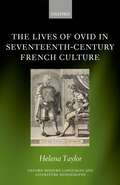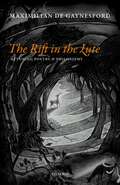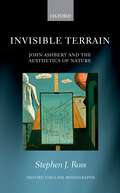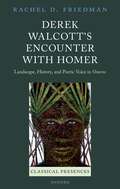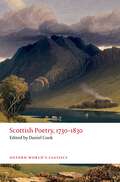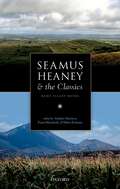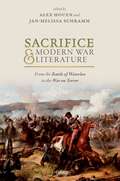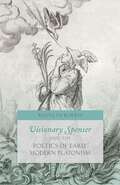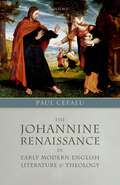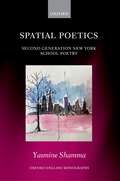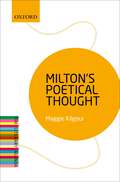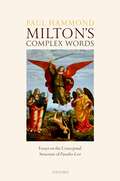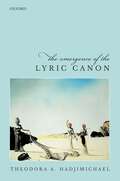- Table View
- List View
The Lives of Ovid in Seventeenth-Century French Culture (Oxford Modern Languages and Literature Monographs)
by Helena TaylorSeventeenth-century France saw one of the most significant 'culture wars' Europe has ever known. Culminating in the Quarrel of the Ancients and Moderns, this was a confrontational, transitional time for the reception of the classics. Helena Taylor explores responses to the life of the ancient Roman poet, Ovid, within this charged atmosphere. To date, criticism has focused on the reception of Ovid's enormously influential work in this period, but little attention has been paid to Ovid's lives and their uses. Through close analysis of a diverse corpus, which includes prefatory Lives, novels, plays, biographical dictionaries, poetry, and memoirs, this study investigates how the figure of Ovid was used to debate literary taste and modernity and to reflect on translation practice. It shows how the narrative of Ovid's life was deployed to explore the politics and poetics of exile writing; and to question the relationship between fiction and history. In so doing, this book identifies two paradoxes: although an ancient poet, Ovid became key to the formulation of aspects of self-consciously 'modern' cultural movements; and while Ovid's work might have adorned the royal palaces of Versailles, the poetry he wrote after being exiled by the Emperor Augustus made him a figure through which to question the relationship between authority and narrative. The Lives of Ovid in Seventeenth-Century French Culture not only nuances understanding of both Ovid and life-writing in this period, but also offers a fresh perspective on classical reception: its paradoxes, uses, and quarrels.
The Lives of Ovid in Seventeenth-Century French Culture (Oxford Modern Languages and Literature Monographs)
by Helena TaylorSeventeenth-century France saw one of the most significant 'culture wars' Europe has ever known. Culminating in the Quarrel of the Ancients and Moderns, this was a confrontational, transitional time for the reception of the classics. Helena Taylor explores responses to the life of the ancient Roman poet, Ovid, within this charged atmosphere. To date, criticism has focused on the reception of Ovid's enormously influential work in this period, but little attention has been paid to Ovid's lives and their uses. Through close analysis of a diverse corpus, which includes prefatory Lives, novels, plays, biographical dictionaries, poetry, and memoirs, this study investigates how the figure of Ovid was used to debate literary taste and modernity and to reflect on translation practice. It shows how the narrative of Ovid's life was deployed to explore the politics and poetics of exile writing; and to question the relationship between fiction and history. In so doing, this book identifies two paradoxes: although an ancient poet, Ovid became key to the formulation of aspects of self-consciously 'modern' cultural movements; and while Ovid's work might have adorned the royal palaces of Versailles, the poetry he wrote after being exiled by the Emperor Augustus made him a figure through which to question the relationship between authority and narrative. The Lives of Ovid in Seventeenth-Century French Culture not only nuances understanding of both Ovid and life-writing in this period, but also offers a fresh perspective on classical reception: its paradoxes, uses, and quarrels.
The Rift in The Lute: Attuning Poetry and Philosophy
by Maximilian de GaynesfordWhat is it for poetry to be serious and to be taken seriously? What is it to be open to poetry, exposed to its force, attuned to what it says and alive to what it does? These are important questions that call equally on poetry and philosophy. But poetry and philosophy, notoriously, have an ancient quarrel. Maximilian de Gaynesford sets out to understand and convert their mutual antipathy into something mutually enhancing, so that we can begin to answer these and other questions. The key to attuning poetry and philosophy lies in the fact that poetic utterances are best appreciated as doing things. For it is as doing things that the speech act approach in analytic philosophy of language tries to understand all utterances. Taking such an approach, this book offers ways to enhance our appreciation of poetry and to develop our understanding of philosophy. It explores work by a range of poets from Chaucer to Geoffrey Hill and J. H. Prynne, and culminates in an extended study of Shakespeare's Sonnets. What work does poetry set itself, and how does this determine the way it is to be judged? What do poets commit themselves to, and what they may be held responsible for? What role does a poet have, or their audience, or their context, in determining the meaning of a poem, what work it is able to achieve? These are the questions that an attuned approach is able to ask and answer.
The Rift in The Lute: Attuning Poetry and Philosophy
by Maximilian de GaynesfordWhat is it for poetry to be serious and to be taken seriously? What is it to be open to poetry, exposed to its force, attuned to what it says and alive to what it does? These are important questions that call equally on poetry and philosophy. But poetry and philosophy, notoriously, have an ancient quarrel. Maximilian de Gaynesford sets out to understand and convert their mutual antipathy into something mutually enhancing, so that we can begin to answer these and other questions. The key to attuning poetry and philosophy lies in the fact that poetic utterances are best appreciated as doing things. For it is as doing things that the speech act approach in analytic philosophy of language tries to understand all utterances. Taking such an approach, this book offers ways to enhance our appreciation of poetry and to develop our understanding of philosophy. It explores work by a range of poets from Chaucer to Geoffrey Hill and J. H. Prynne, and culminates in an extended study of Shakespeare's Sonnets. What work does poetry set itself, and how does this determine the way it is to be judged? What do poets commit themselves to, and what they may be held responsible for? What role does a poet have, or their audience, or their context, in determining the meaning of a poem, what work it is able to achieve? These are the questions that an attuned approach is able to ask and answer.
Invisible Terrain: John Ashbery and the Aesthetics of Nature (Oxford English Monographs)
by Stephen J. RossIn his debut collection, Some Trees (1956), the American poet John Ashbery poses a question that resonates across his oeuvre and much of modern art: 'How could he explain to them his prayer / that nature, not art, might usurp the canvas?' When Ashbery asks this strange question, he joins a host of transatlantic avant-gardists—from the Dadaists to the 1960s neo-avant-gardists and beyond—who have dreamed of turning art into nature, of creating art that would be 'valid solely on its own terms, in the way nature itself is valid, in the way a landscape—not its picture—is aesthetically valid' (Clement Greenberg, 1939). Invisible Terrain reads Ashbery as a bold intermediary between avant-garde anti-mimeticism and the long western nature poetic tradition. In chronicling Ashbery's articulation of 'a completely new kind of realism' and his engagement with figures ranging from Wordsworth to Warhol, the book presents a broader case study of nature's dramatic transformation into a resolutely unnatural aesthetic resource in 20th-century art and literature. The story begins in the late 1940s with the Abstract Expressionist valorization of process, surface, and immediacy—summed up by Jackson Pollock's famous quip, 'I am Nature'—that so influenced the early New York School poets. It ends with 'Breezeway,' a poem about Hurricane Sandy. Along the way, the project documents Ashbery's strategies for literalizing the 'stream of consciousness' metaphor, his negotiation of pastoral and politics during the Vietnam War, and his investment in 'bad' nature poetry.
Invisible Terrain: John Ashbery and the Aesthetics of Nature (Oxford English Monographs)
by Stephen J. RossIn his debut collection, Some Trees (1956), the American poet John Ashbery poses a question that resonates across his oeuvre and much of modern art: 'How could he explain to them his prayer / that nature, not art, might usurp the canvas?' When Ashbery asks this strange question, he joins a host of transatlantic avant-gardists—from the Dadaists to the 1960s neo-avant-gardists and beyond—who have dreamed of turning art into nature, of creating art that would be 'valid solely on its own terms, in the way nature itself is valid, in the way a landscape—not its picture—is aesthetically valid' (Clement Greenberg, 1939). Invisible Terrain reads Ashbery as a bold intermediary between avant-garde anti-mimeticism and the long western nature poetic tradition. In chronicling Ashbery's articulation of 'a completely new kind of realism' and his engagement with figures ranging from Wordsworth to Warhol, the book presents a broader case study of nature's dramatic transformation into a resolutely unnatural aesthetic resource in 20th-century art and literature. The story begins in the late 1940s with the Abstract Expressionist valorization of process, surface, and immediacy—summed up by Jackson Pollock's famous quip, 'I am Nature'—that so influenced the early New York School poets. It ends with 'Breezeway,' a poem about Hurricane Sandy. Along the way, the project documents Ashbery's strategies for literalizing the 'stream of consciousness' metaphor, his negotiation of pastoral and politics during the Vietnam War, and his investment in 'bad' nature poetry.
Derek Walcott's Encounter with Homer: Landscape, History, and Poetic Voice in Omeros (Classical Presences)
by Rachel D. FriedmanDerek Walcott's Encounter with Homer puts Derek Walcott's epic poem Omeros in conversation with Homer, especially the Odyssey, to show how reading them against each other changes our understanding of the poems of both poets. It explores Walcott's conscious use of the Odyssey and the Homeric persona of Omeros to explore his own deepening relationship with his craft and his identity as a Caribbean poet. Walcott's ability to serve as the vessel of history for his people and their landscapes rests on his transformation into (and self-perception as) Homer's contemporary and equal. Central to the project of Omeros is thus an account of his shift from a diachronic to synchronic relationship with Homer: over the course of the poem his poetic persona, the "Poet", and Homer come to occupy the same temporality and creative space. By locating the poems of Walcott and Homer in a zone of vibrant and unexpected encounter, Rachel Friedman demonstrates how they can be seen as mutually informing texts, each made richer in the presence of the other. The argument follows two intertwined thematic threads. The first focuses on the poems' landscapes and seascapes and the ways in which Omeros reworks the Odyssey's affective geography. While the Odyssey represents the sea as a dangerous space and valorizes life on land, Walcott reverses this trajectory from sea to land, bearing witness to the painful histories carried in the St Lucian soil and relocating homecoming to the space of the Caribbean Sea, a space which accommodates diasporic histories and the imagining of fluid forms of emplacement. The second thread focuses on Walcott's poetic persona: his journey in and out of the poem and his positioning of himself as a "tribal poet" like Homer. Central to the project of Omeros is the Poet's account of the processes by which he becomes the poet who can adequately give voice to the histories of his people and the archipelago they inhabit.
Derek Walcott's Encounter with Homer: Landscape, History, and Poetic Voice in Omeros (Classical Presences)
by Rachel D. FriedmanDerek Walcott's Encounter with Homer puts Derek Walcott's epic poem Omeros in conversation with Homer, especially the Odyssey, to show how reading them against each other changes our understanding of the poems of both poets. It explores Walcott's conscious use of the Odyssey and the Homeric persona of Omeros to explore his own deepening relationship with his craft and his identity as a Caribbean poet. Walcott's ability to serve as the vessel of history for his people and their landscapes rests on his transformation into (and self-perception as) Homer's contemporary and equal. Central to the project of Omeros is thus an account of his shift from a diachronic to synchronic relationship with Homer: over the course of the poem his poetic persona, the "Poet", and Homer come to occupy the same temporality and creative space. By locating the poems of Walcott and Homer in a zone of vibrant and unexpected encounter, Rachel Friedman demonstrates how they can be seen as mutually informing texts, each made richer in the presence of the other. The argument follows two intertwined thematic threads. The first focuses on the poems' landscapes and seascapes and the ways in which Omeros reworks the Odyssey's affective geography. While the Odyssey represents the sea as a dangerous space and valorizes life on land, Walcott reverses this trajectory from sea to land, bearing witness to the painful histories carried in the St Lucian soil and relocating homecoming to the space of the Caribbean Sea, a space which accommodates diasporic histories and the imagining of fluid forms of emplacement. The second thread focuses on Walcott's poetic persona: his journey in and out of the poem and his positioning of himself as a "tribal poet" like Homer. Central to the project of Omeros is the Poet's account of the processes by which he becomes the poet who can adequately give voice to the histories of his people and the archipelago they inhabit.
Scottish Poetry, 1730-1830 (Oxford World's Classics)
The pride o' a' our Scottish plain; Thou gi'es us joy to hear thy strain, (Janet Little, 'An Epistle to Mr Robert Burns') The 18th century saw Scotland become one of the leading international centres of literature, philosophy, and publishing and yet still retain its lively oral tradition of ballads and poetry. Scottish Poetry, 1730-1830 edited by Daniel Cook contains over 200 poems and songs written in Scots, English, and Gaelic which reflect this vibrant period of literary flourishing. The collection places Burns, Scott, and other major writers alongside lesser known or even entirely forgotten figures. Gaelic poets feature in their original language and in translation, along with many important long poems in their entirety. Lairds and ladies jostle with labouring-class writers, satirists with sentimentalists, Gaelic bards with Gothic balladists, rural singers with urbanite odists, and together they reveal the unrivalled range of Scottish poetry. ABOUT THE SERIES: For over 100 years Oxford World's Classics has made available the widest range of literature from around the globe. Each affordable volume reflects Oxford's commitment to scholarship, providing the most accurate text plus a wealth of other valuable features, including expert introductions by leading authorities, helpful notes to clarify the text, up-to-date bibliographies for further study, and much more.
Scottish Poetry, 1730-1830 (Oxford World's Classics)
by Daniel CookThe pride o' a' our Scottish plain; Thou gi'es us joy to hear thy strain, (Janet Little, 'An Epistle to Mr Robert Burns') The 18th century saw Scotland become one of the leading international centres of literature, philosophy, and publishing and yet still retain its lively oral tradition of ballads and poetry. Scottish Poetry, 1730-1830 edited by Daniel Cook contains over 200 poems and songs written in Scots, English, and Gaelic which reflect this vibrant period of literary flourishing. The collection places Burns, Scott, and other major writers alongside lesser known or even entirely forgotten figures. Gaelic poets feature in their original language and in translation, along with many important long poems in their entirety. Lairds and ladies jostle with labouring-class writers, satirists with sentimentalists, Gaelic bards with Gothic balladists, rural singers with urbanite odists, and together they reveal the unrivalled range of Scottish poetry. ABOUT THE SERIES: For over 100 years Oxford World's Classics has made available the widest range of literature from around the globe. Each affordable volume reflects Oxford's commitment to scholarship, providing the most accurate text plus a wealth of other valuable features, including expert introductions by leading authorities, helpful notes to clarify the text, up-to-date bibliographies for further study, and much more.
Seamus Heaney and the Classics: Bann Valley Muses
Seamus Heaney, the great Irish poet, made a significant contribution to classical reception in modern poetry; though occasional essays have appeared in the past, this volume is the first to be wholly dedicated to this perspective on his work. Comprising literary criticism by scholars of both classical reception and contemporary literature in English, it includes contributions from critics who are also poets, as well as from theatre practitioners on their interpretations and productions of Heaney's versions of Greek drama; well-known names are joined by early-career contributors, and friends and collaborators of Heaney sit alongside those who admired him from afar. The papers focus on two main areas: Heaney's fascination with Greek drama and myth - shown primarily in his two Sophoclean versions, but also in his engagement in other poems with Hesiod, with Aeschylus' Agamemnon, and with myths such as that of Antaeus - and his interest in Latin poetry, primarily that of Virgil but also that of Horace; a version of an Horatian ode was famously the vehicle for Heaney's comment on the events of 11 September 2001 in 'Anything Can Happen' (District and Circle, 2006). Although a number of the contributions cover similar material, they do so from distinctively different angles: for example, Heaney's interest in Virgil is linked with the traditions of Irish poetry, his capacity as a translator, and his annotations in his own text of a standard translation, as well as being investigated in its long development over his poetic career, while his Greek dramas are considered as verbal poetry, as comments on Irish politics, and as stage-plays with concomitant issues of production and interpretation. Heaney's posthumous translation of Virgil's Aeneid VI (2016) comes in for considerable attention, and this will be the first volume to study this major work from several angles.
Seamus Heaney and the Classics: Bann Valley Muses
by Stephen Harrison Fiona Macintosh Helen EastmanSeamus Heaney, the great Irish poet, made a significant contribution to classical reception in modern poetry; though occasional essays have appeared in the past, this volume is the first to be wholly dedicated to this perspective on his work. Comprising literary criticism by scholars of both classical reception and contemporary literature in English, it includes contributions from critics who are also poets, as well as from theatre practitioners on their interpretations and productions of Heaney's versions of Greek drama; well-known names are joined by early-career contributors, and friends and collaborators of Heaney sit alongside those who admired him from afar. The papers focus on two main areas: Heaney's fascination with Greek drama and myth - shown primarily in his two Sophoclean versions, but also in his engagement in other poems with Hesiod, with Aeschylus' Agamemnon, and with myths such as that of Antaeus - and his interest in Latin poetry, primarily that of Virgil but also that of Horace; a version of an Horatian ode was famously the vehicle for Heaney's comment on the events of 11 September 2001 in 'Anything Can Happen' (District and Circle, 2006). Although a number of the contributions cover similar material, they do so from distinctively different angles: for example, Heaney's interest in Virgil is linked with the traditions of Irish poetry, his capacity as a translator, and his annotations in his own text of a standard translation, as well as being investigated in its long development over his poetic career, while his Greek dramas are considered as verbal poetry, as comments on Irish politics, and as stage-plays with concomitant issues of production and interpretation. Heaney's posthumous translation of Virgil's Aeneid VI (2016) comes in for considerable attention, and this will be the first volume to study this major work from several angles.
Sacrifice and Modern War Literature: The Battle of Waterloo to the War on Terror
Sacrifice and Modern War Literature is the first book to explore how writers from the early nineteenth century to the present have addressed the intimacy of sacrifice and war. It has been common for critics to argue that after the First World War many of the cultural and religious values associated with sacrifice have been increasingly rejected by writers and others. However, this volume shows that literature has continued to address how different conceptions of sacrifice have been invoked in times of war to convert losses into gains or ideals. While those conceptions have sometimes been rooted in a secular rationalism that values lost lives in terms of political or national victories, spiritual and religious conceptions of sacrifice are also still in evidence, as with the 'martyrdom operations' of jihadis fighting against the 'war on terror'. Each chapter presents fresh insights into the literature of a particular conflict and the contributions explore major war writers including Wordsworth, Kipling, Ford Madox Ford, and Elizabeth Bowen, as well as lesser known authors such as Dora Sigerson, Richard Aldington, Thomas Kinsella, and Nadeem Aslam. The volume covers multiple genres including novels, poetry (particularly elegy and lyric), memoirs, and some films. The contributions address a rich array of topics related to wartime sacrifice including scapegoating, martyrdom, religious faith, tragedy, heroism, altruism, 'bare life', atonement, and redemption.
Visionary Spenser and the Poetics of Early Modern Platonism
by Kenneth BorrisPlatonic concerns and conceptions profoundly affected early modern English and continental poetics, yet the effects have had little attention. This book defines Platonism's roles in early modern theories of literature, then reappraise the Platonizing major poet Edmund Spenser. It makes important new contributions to the knowledge of early modern European poetics and advances our understanding of Spenser's role and significance in English literary history. Literary Platonism energized pursuits of the sublime, and knowledge of this approach to poetry yields cogent new understandings of Spenser's poetics, his principal texts, his poetic vocation, and his cultural influence. By combining Christian resources with doctrines of Platonic poetics such as the poet's and lover's inspirational furies, the revelatory significance of beauty, and the importance of imitating exalted ideals rather than the world, he sought to attain a visionary sublimity that would ensure his enduring national significance, and he thereby became a seminal figure in the English literary "line of vision" including Milton and Blake among others. Although readings of Spenser's Shepheardes Calender typically bypass Plato's Phaedrus, this text deeply informs the Calender's treatments of beauty, inspiration, poetry's psychagogic power, and its national responsibilities. In The Faerie Queene, both heroism and visionary poetics arise from the stimuli of love and beauty conceived Platonically, and idealized mimesis produces its faeryland. Faery's queen, projected from Elizabeth I as in Platonic idealization of the beloved, not only pertains to temporal governance but also points toward the transcendental Ideas and divinity. Whereas Plato's Republic valorizes philosophy for bringing enlightenment to counter society's illusions, Spenser champions the learned and enraptured poetic imagination, and proceeds as such a philosopher-poet.
Visionary Spenser and the Poetics of Early Modern Platonism
by Kenneth BorrisPlatonic concerns and conceptions profoundly affected early modern English and continental poetics, yet the effects have had little attention. This book defines Platonism's roles in early modern theories of literature, then reappraise the Platonizing major poet Edmund Spenser. It makes important new contributions to the knowledge of early modern European poetics and advances our understanding of Spenser's role and significance in English literary history. Literary Platonism energized pursuits of the sublime, and knowledge of this approach to poetry yields cogent new understandings of Spenser's poetics, his principal texts, his poetic vocation, and his cultural influence. By combining Christian resources with doctrines of Platonic poetics such as the poet's and lover's inspirational furies, the revelatory significance of beauty, and the importance of imitating exalted ideals rather than the world, he sought to attain a visionary sublimity that would ensure his enduring national significance, and he thereby became a seminal figure in the English literary "line of vision" including Milton and Blake among others. Although readings of Spenser's Shepheardes Calender typically bypass Plato's Phaedrus, this text deeply informs the Calender's treatments of beauty, inspiration, poetry's psychagogic power, and its national responsibilities. In The Faerie Queene, both heroism and visionary poetics arise from the stimuli of love and beauty conceived Platonically, and idealized mimesis produces its faeryland. Faery's queen, projected from Elizabeth I as in Platonic idealization of the beloved, not only pertains to temporal governance but also points toward the transcendental Ideas and divinity. Whereas Plato's Republic valorizes philosophy for bringing enlightenment to counter society's illusions, Spenser champions the learned and enraptured poetic imagination, and proceeds as such a philosopher-poet.
The Johannine Renaissance in Early Modern English Literature and Theology
by Paul CefaluThe Johannine Renaissance in Early Modern English Literature and Theology argues that the Fourth Gospel and First Epistle of Saint John the Evangelist were so influential during the early modern period in England as to share with Pauline theology pride of place as leading apostolic texts on matters Christological, sacramental, pneumatological, and political. The book argues further that, in several instances, Johannine theology is more central than both Pauline theology and the Synoptic theology of Matthew, Mark, and Luke, particularly with regard to early modern polemicizing on the Trinity, distinctions between agape and eros, and the ideologies of radical dissent, especially the seventeenth-century antinomian challenge of free grace to traditional Puritan Pietism. In particular, early modern religious poetry, including works by Robert Southwell, George Herbert, John Donne, Richard Crashaw, Thomas Traherne, and Anna Trapnel, embraces a distinctive form of Johannine devotion that emphasizes the divine rather than human nature of Christ; the belief that salvation is achieved more through revelation than objective atonement and expiatory sin; a realized eschatology; a robust doctrine of assurance and comfort; and a stylistic and rhetorical approach to representing these theological features that often emulates John's mode of discipleship misunderstanding and dramatic irony. Early modern Johannine devotion assumes that religious lyrics often express a revelatory poetics that aims to clarify, typically through the use of dramatic irony, some of the deepest mysteries of the Fourth Gospel and First Epistle.
The Johannine Renaissance in Early Modern English Literature and Theology
by Paul CefaluThe Johannine Renaissance in Early Modern English Literature and Theology argues that the Fourth Gospel and First Epistle of Saint John the Evangelist were so influential during the early modern period in England as to share with Pauline theology pride of place as leading apostolic texts on matters Christological, sacramental, pneumatological, and political. The book argues further that, in several instances, Johannine theology is more central than both Pauline theology and the Synoptic theology of Matthew, Mark, and Luke, particularly with regard to early modern polemicizing on the Trinity, distinctions between agape and eros, and the ideologies of radical dissent, especially the seventeenth-century antinomian challenge of free grace to traditional Puritan Pietism. In particular, early modern religious poetry, including works by Robert Southwell, George Herbert, John Donne, Richard Crashaw, Thomas Traherne, and Anna Trapnel, embraces a distinctive form of Johannine devotion that emphasizes the divine rather than human nature of Christ; the belief that salvation is achieved more through revelation than objective atonement and expiatory sin; a realized eschatology; a robust doctrine of assurance and comfort; and a stylistic and rhetorical approach to representing these theological features that often emulates John's mode of discipleship misunderstanding and dramatic irony. Early modern Johannine devotion assumes that religious lyrics often express a revelatory poetics that aims to clarify, typically through the use of dramatic irony, some of the deepest mysteries of the Fourth Gospel and First Epistle.
Spatial Poetics: Second Generation New York School Poetry (Oxford English Monographs)
by Yasmine ShammaWhat is the relationship between the spaces we inhabit and the spaces we create? Does living in a messy downtown New York City apartment automatically translate to writing a messy New York School poem? This volume addresses the 'environment' of the urban apartment, illuminating the relationship between the structures of New York City apartments and that of New York School poems. It utilizes the lens of urban and spatial theory to widen the possibilities afforded by New Critical and reader-response readings of this postmodern American poetry. In drawing this connection between consciousness and form, it draws on various senses of the environment as informing influence, inviting avant-garde American poetry to be reconsidered as uniquely organic in its responsiveness to its surroundings. Focusing exclusively and comprehensively on Second Generation New York School poetry, this is the first book-length study to attend to the poetry of this postmodern American movement, encouraging American poetry scholars to resituate New York School poetry within larger critical narratives of postmodern innovation.
Spatial Poetics: Second Generation New York School Poetry (Oxford English Monographs)
by Yasmine ShammaWhat is the relationship between the spaces we inhabit and the spaces we create? Does living in a messy downtown New York City apartment automatically translate to writing a messy New York School poem? This volume addresses the 'environment' of the urban apartment, illuminating the relationship between the structures of New York City apartments and that of New York School poems. It utilizes the lens of urban and spatial theory to widen the possibilities afforded by New Critical and reader-response readings of this postmodern American poetry. In drawing this connection between consciousness and form, it draws on various senses of the environment as informing influence, inviting avant-garde American poetry to be reconsidered as uniquely organic in its responsiveness to its surroundings. Focusing exclusively and comprehensively on Second Generation New York School poetry, this is the first book-length study to attend to the poetry of this postmodern American movement, encouraging American poetry scholars to resituate New York School poetry within larger critical narratives of postmodern innovation.
Milton's Poetical Thought: The Literary Agenda (The Literary Agenda)
by Maggie KilgourA defence of the importance of poetry that studies one of the greatest poets of the English tradition: John Milton. The Literary Agenda is a series of short polemical monographs about the importance of literature and of reading in the wider world and about the state of literary education inside schools and universities. The category of 'the literary' has always been contentious. What is clear, however, is how increasingly it is dismissed or is unrecognised as a way of thinking or an arena for thought. It is sceptically challenged from within, for example, by the sometimes rival claims of cultural history, contextualized explanation, or media studies. It is shaken from without by even greater pressures: by economic exigency and the severe social attitudes that can follow from it; by technological change that may leave the traditional forms of serious human communication looking merely antiquated. For just these reasons this is the right time for renewal, to start reinvigorated work into the meaning and value of literary reading. Why would anyone read John Milton today? To many, poetry in general is an irrelevant and even irresponsible luxury that we cannot afford in a time of environmental and social crisis. The work of a seventeenth-century 'Puritan' might seem especially obscure and out of touch with our needs. But this book argues that Milton offers us one of the most powerful arguments for the importance of poetry today, both representing in his poetry and demonstrating through his own life, the transformative and sustaining force of the human imagination even in times of greatest upheaval. Writing out of his own experience of loss and disappointment, he insists that poetry is a form of knowledge, a way of seeing and understanding the world around us, others, and indeed ourselves. He uses the resources of poetry—its language, imagery, and forms—to challenge and shake us up, making us think in unfamiliar ways and expanding our imagination and our sense of the possibilities in our lives. Milton insists that poetry gives us knowledge of truths we otherwise would never apprehend; it enriches the experience of both writers and readers and makes us creative and fully realized human beings.
Milton's Poetical Thought: The Literary Agenda (The Literary Agenda)
by Maggie KilgourA defence of the importance of poetry that studies one of the greatest poets of the English tradition: John Milton. The Literary Agenda is a series of short polemical monographs about the importance of literature and of reading in the wider world and about the state of literary education inside schools and universities. The category of 'the literary' has always been contentious. What is clear, however, is how increasingly it is dismissed or is unrecognised as a way of thinking or an arena for thought. It is sceptically challenged from within, for example, by the sometimes rival claims of cultural history, contextualized explanation, or media studies. It is shaken from without by even greater pressures: by economic exigency and the severe social attitudes that can follow from it; by technological change that may leave the traditional forms of serious human communication looking merely antiquated. For just these reasons this is the right time for renewal, to start reinvigorated work into the meaning and value of literary reading. Why would anyone read John Milton today? To many, poetry in general is an irrelevant and even irresponsible luxury that we cannot afford in a time of environmental and social crisis. The work of a seventeenth-century 'Puritan' might seem especially obscure and out of touch with our needs. But this book argues that Milton offers us one of the most powerful arguments for the importance of poetry today, both representing in his poetry and demonstrating through his own life, the transformative and sustaining force of the human imagination even in times of greatest upheaval. Writing out of his own experience of loss and disappointment, he insists that poetry is a form of knowledge, a way of seeing and understanding the world around us, others, and indeed ourselves. He uses the resources of poetry—its language, imagery, and forms—to challenge and shake us up, making us think in unfamiliar ways and expanding our imagination and our sense of the possibilities in our lives. Milton insists that poetry gives us knowledge of truths we otherwise would never apprehend; it enriches the experience of both writers and readers and makes us creative and fully realized human beings.
Milton's Complex Words: Essays on the Conceptual Structure of Paradise Lost
by Paul HammondEvery major poet or philosopher develops their own distinctive semantic field around those terms which matter most to them, or which contribute most profoundly to the imagined world of a particular work. This book explores the specific meanings which Milton develops around key words in Paradise Lost. Some of these are theological or philosophical terms (e.g. 'evil', 'grace', 'reason'); others are words which shape the imagined world of the poem (e.g. 'dark', 'fall', 'within'); yet others are small words or even prefixes which subtly move the argument in new directions (e.g. 'if', 'not', 're-'). Milton seems to expect his readers to be alert to the special semantic field which he creates around such words, often by infusing them with biblical and literary connotations, and activating their etymological roots; alert also to the patterns created by the repetitions of such words, and particularly to their diverse use (and often their blatant misuse) by different characters. To understand the migrations and malleability of key words is part of the education of Milton's reader.
Milton's Complex Words: Essays on the Conceptual Structure of Paradise Lost
by Paul HammondEvery major poet or philosopher develops their own distinctive semantic field around those terms which matter most to them, or which contribute most profoundly to the imagined world of a particular work. This book explores the specific meanings which Milton develops around key words in Paradise Lost. Some of these are theological or philosophical terms (e.g. 'evil', 'grace', 'reason'); others are words which shape the imagined world of the poem (e.g. 'dark', 'fall', 'within'); yet others are small words or even prefixes which subtly move the argument in new directions (e.g. 'if', 'not', 're-'). Milton seems to expect his readers to be alert to the special semantic field which he creates around such words, often by infusing them with biblical and literary connotations, and activating their etymological roots; alert also to the patterns created by the repetitions of such words, and particularly to their diverse use (and often their blatant misuse) by different characters. To understand the migrations and malleability of key words is part of the education of Milton's reader.
The Emergence of the Lyric Canon
by Theodora A. HadjimichaelThe Hellenistic period was an era of literary canons, of privileged texts and collections. One of the most stable of these consisted of the nine (rarely ten) lyric poets: whether the selection was based on poetic quality, popularity, or the availability of texts in the Library of Alexandria, the Lyric Canon offers a valuable and revealing window on the reception and survival of lyric in antiquity. This volume explores the complexities inherent in the process by which lyric poetry was canonized, and discusses questions connected with the textual transmission and preservation of lyric poems from the archaic period through to the Hellenistic era. It firstly contextualizes lyric poetry geographically, and then focuses on a broad range of sources that played a critical role in the survival of lyric poetry - in particular, comedy, Plato, Aristotle's Peripatetic school, and the Hellenistic scholars - to discuss the reception of the nine canonical lyric poets and their work. By exploring the ways in which fifth- and fourth-century sources interpreted lyric material, and the role they played both in the scholarly work of the Alexandrians and in the creation of what we conventionally call the Hellenistic Lyric Canon, it elucidates what can be defined as the prevailing pattern in the transmission of lyric poetry, as well as the place of Bacchylides as a puzzling exception to this norm. The overall discussion conclusively demonstrates that the canonizing process of the lyric poets was already at work from the fifth century BC and that it is reflected both in the evaluation of lyric by fourth-century thinkers and in the activities of the Hellenistic scholars in the Library of Alexandria.
The Emergence of the Lyric Canon
by Theodora A. HadjimichaelThe Hellenistic period was an era of literary canons, of privileged texts and collections. One of the most stable of these consisted of the nine (rarely ten) lyric poets: whether the selection was based on poetic quality, popularity, or the availability of texts in the Library of Alexandria, the Lyric Canon offers a valuable and revealing window on the reception and survival of lyric in antiquity. This volume explores the complexities inherent in the process by which lyric poetry was canonized, and discusses questions connected with the textual transmission and preservation of lyric poems from the archaic period through to the Hellenistic era. It firstly contextualizes lyric poetry geographically, and then focuses on a broad range of sources that played a critical role in the survival of lyric poetry - in particular, comedy, Plato, Aristotle's Peripatetic school, and the Hellenistic scholars - to discuss the reception of the nine canonical lyric poets and their work. By exploring the ways in which fifth- and fourth-century sources interpreted lyric material, and the role they played both in the scholarly work of the Alexandrians and in the creation of what we conventionally call the Hellenistic Lyric Canon, it elucidates what can be defined as the prevailing pattern in the transmission of lyric poetry, as well as the place of Bacchylides as a puzzling exception to this norm. The overall discussion conclusively demonstrates that the canonizing process of the lyric poets was already at work from the fifth century BC and that it is reflected both in the evaluation of lyric by fourth-century thinkers and in the activities of the Hellenistic scholars in the Library of Alexandria.
